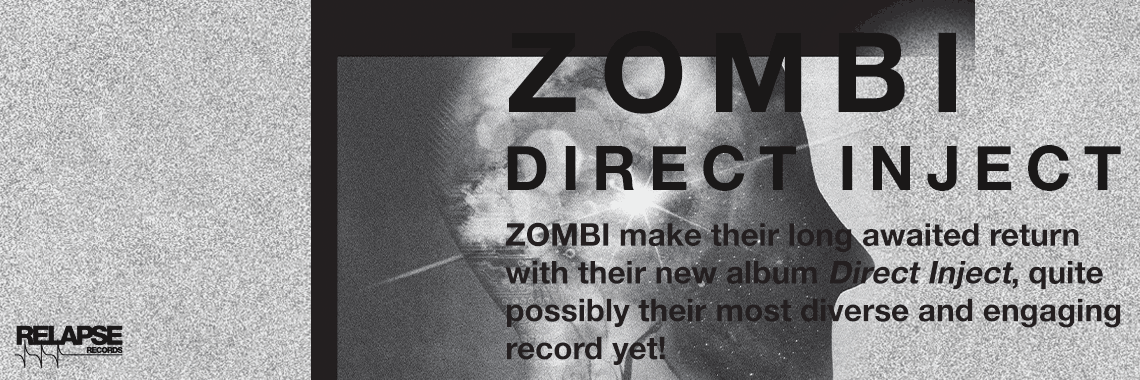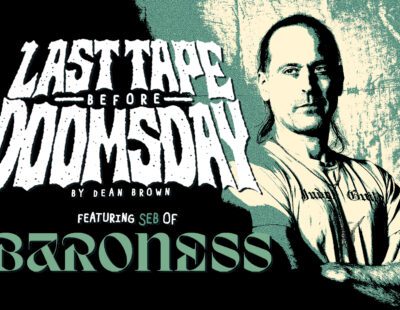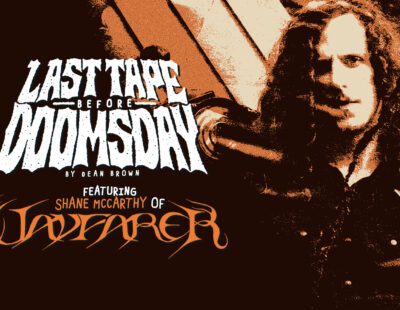** After 21 years of housing some of the finest metal acts known to mankind, British label Music For Nations closed shop in 2004. The label was folded in Sony Entertainment’s Zomba Record Group and mothballed for eternity. That’s usually how these things go. Usually. Well, 11 years on the shelf and in the books wasn’t enough to keep a quality name like Music For Nations down. In 2015, Sony rekindled the legendary label’s fire, hoping to catch metaldom’s fierce loyalty and the music industry’s sudden re-acceptance of vinyl (it sells). To commemorate Music For Nations new life, the label’s releasing reissues of key back catalog pieces, namely Opeth’s Lamentations opus and Paradise Lost’s seminal Shades of God effort, on picture disc for the first time. Since we here at Decibel were huge fans of the label and many of its bands (no comment on Apes, Pigs & Spacemen and Dearly Beheaded), we put together a Top 10 Music For Nations Releases of All Time. Now, we considered both direct signings and licenses, which means we’re pretty sure you’ll agree with at least 50 percent of the list.
10. Anathema – The Silent Engima
(Peaceville / MFN) 1995
Anathema crawled out of their Darren White period pissed off and profoundly depressed. The Silent Enigma, the Liverpudlians’ second full-length, originally featured White—Mudrian has physical proof—but for some reason (“musical differences” was the old-school way of saying “we don’t get along”) Anathema’s passionate/reasoned frontman was jettisoned from the recordings. When guitarist Vincent Cavanagh stepped up to the plate, Anathema took on a whole different shape and tone. The Silent Enigma is Anathema at their most depressive, most despondent, and most violent. This album is a reaction. To the world. To life. To what they were going through at the time. The Silent Enigma features Anathema’s most intense—sonically and emotionally—songs to date. “Restless Oblivion”, “Sunset of Age”, “Cerulean Twilight”, “Nocturnal Emission”, and “A Dying Wish” are undoubtedly brutal, but not in the traditional sense. The Silent Enigma takes a piece out of the listener, leaving its fortunate victims gasping for life after instrumental “Black Orchid” strums out. Unsung by all measures, The Silent Enigma deserves new light.
9. Lost Horizon – Awakening the World
(MFN) 2001
By the time, Lost Horizon, featuring ex-death metal maven Wojtek Lisicki (Luciferion), hit kids in 2001, the resurgence of traditional heavy metal—coined “power metal”—was well on its way to the bank. HammerFall had three albums in the bag, Helloween were back in the saddle (Dark Ride was excellent!), Iron Maiden returned to glory, and Stratovarius had transitioned from Japan-only phenom to continental powerhouse. MFN thought they had a winner with Sweden’s Lost Horizon. Actually, they did, just not the commercial landslide of what was happening on Nuclear Blast and elsewhere. Lisicki was a cunning songsmith, his death metal-isms completely out of the picture on Awakening the World. Frontman Daniel Heiman was unparalleled as well. That he’s still sitting in the shadows of obscurity is a bit of wonder, really. The rhythm section of Christian Nyqvist and Martin Furängen (also ex-Luciferion) was one of the best of the era, putting most rhythm sections to shame, save for McBrain and Harris. Cheesy beyond all doubt, but oh so fucking good (quality reigns supreme!), songs like “Heart of Storm”, “Sworn in the Metal Wind”, “Denial of Fate”, “The Kingdom of My Will”, and, especially, super-gem “World Through My Fateless Eyes” were power anthems of the era, marchable and hailable at once. If there’s a lost power metal album waiting for Game of Thrones nerds to discover, it’s Awakening the World. Shirtless and all.
8. Helstar – Burning Star
(Combat / MFN) 1984
There aren’t many genuine American heavy metal bands as unheralded as Texan power metallers Helstar. The group’s 1984 debut, Burning Star, helped pave the way for Americans to walk their own path. Different from but drawing upon vintage Iron Maiden, Helstar were efficient, heavy, and song-driven. But what really set the group apart—from Americans and Europeans—was the super-caterwauling of frontman James Rivera. His vocal range was impressive then, and upon revisit is impressive now. Key tracks are opener “Burning Star”, “Shadows of Iga”, “Dracula’s Castle”, and “Toward The Unknown”. While other American heavy metal acts were also starting out—Armored Saint, Dokken, Fates Warning, Jag Panzer, and Metal Church—it’s a damned shame Helstar went largely unnoticed.
7. Cradle of Filth – Dusk… and Her Embrace
(MFN) 1996
There were few black metal albums as anticipated as Cradle of Filth’s second full-length, Dusk… and Her Embrace, in 1996. The Brits had made major headlines from the extremity of music and merch in the mid-‘90s, and the move from underground outfit Cacophonous Records to Music For Nations was a major coup. One, it suddenly meant black metal, as a genre and a movement, had commercial potential. Two, Cradle of Filth were primed to take black metal out of its primitive origins. True, the Norwegians were well on their way to add layers of complexity and sophistication to black metal, but the Brits infused literary and aesthetic qualities that were instantly liked by fans of Victorian era England and its fascination with the supernatural and the occult. No band was better poised to pose in Bard shirts with naked chicks than Cradle of Filth. They had the look, they had the smarts, the overwrought lyrics, and they had the songs. The Kit Woolven-produced Dusk… and Her Embrace had a bevy of infernal tunes: “Heaven Torn Asunder”, “Funeral in Carpathia”, “Malice Through the Looking-Glass”, and “Haunted Shores”—featuring Venom’s Cronos—transformed black metal permanently. Few bands were able to keep up with Cradle of Filth at the time, and, in hindsight, few bands are able to keep up with Dusk… and Her Embrace now.
6. Manowar – Into Glory Ride
(Megaforce / MFN) 1983
Four dudes in loin cloths, furry boots, wielding swords… From today’s standpoint, the album cover to Manowar effort Into Glory Ride is laughably macho. Then again, it’s kind of hard to be pick Into Glory Ride over its follow-up Hail to England. They both have their qualities, but Into Glory Ride features “Gloves of Metal”, “Warlord”, and “Hatred”. Also, Into Glory Ride’s a bit different of an album. There’s a prolonged quality to it, as if Manowar were suddenly aware they’re musicians, and not just heavy metal musicians either. So, sometimes with failure, they experimented, slowed things down, changed up their Battle Hymn-type groove. This is also Scott Columbus’ (RIP) first release with Manowar, having replaced Donnie Hamzik. Columbus gives Manowar a proper pounding, too. He’s right on the money on almost the entire full-length, but he’s particularly mean on “Gates of Valhalla” and “Secret of Steel”. Long-time fans also argue that this is Eric Adams’ best effort to date. Certainly, Adams is strong, confident, and has a knack for hitting high on the register, though this in particularly isn’t his best trait. He was, at this point, a great vocalist, perfect for the material and the obviously, Nordic inspired lyrical content.
5. Paradise Lost – Icon
(MFN) 1993
Following strongly on the success of landmark album, Shades of God, Paradise Lost nearly exploded into the upper atmosphere (rest of world, not the U.S.) with songs like “Embers Fire”, “Colossal Rains”, and “True Belief” on their fourth album, Icon. As a result, the Brits were primed to take over Metallica’s throne—at least that’s what the UK press had us believe at the time—in 1993. This is largely due to Paradise Lost finally abandoning their death/doom roots, opting for a more straightforward heavy metal/rock style, a kind of approach that appealed to both Metallica and Sisters of Mercy fans. Guitarist Greg Mackintosh, though different from his early days of “Angel Tears” and “Dead Emotion”, upped his game on Icon. His riffs were big, his melodies strong, and his songwriting fantastic. Similarly, frontman Nick Holmes also changed his tune. By singing instead of growling, Holmes set the standard for frontmen the world over, even if his delivery, by this time, was informed by Hetfield. Additionally, Icon is also producer Simon Efemey’s finest hour. The clarity and power of the production set Paradise Lost apart from other bands trying to reach for the stars.
4. Savatage – Sirens
(Par / MFN) 1985
Though Florida’s Savatage were name-dropped by musicians like Chuck Schuldiner, they were always—even during the group’s Hall of the Mountain King days—appreciated more overseas. The group’s debut, Sirens, features an interesting cross-section of material. One aspect has, well, “Sirens”—a singular, powerful track that still remains largely obscure to most metallers—“Holocaust”, “Rage”, and “Living for the Night”. Now that metal is an easily discoverable genre—thanks to Youtube, et al.—it’s surprising to not hear more folks talking up Sirens. Then again, the debut also features mundane material such as “Twisted Little Sister” and “Out on the Streets”. It’s almost as if Savatage were stuck: one half in legacy mode—where stereotypical boogie rock goes to die on Tuesday nights—and the other half in “let’s write some classics”, such as the aforementioned title track. Certainly, the Olivia brothers were a talented duo, and the rhythm section of Keith Collins and Steve Wacholz carried their own weight, but something seemed off at times. If Side B was as good as Side A, Savatage, with proper label handling in the U.S., would be mentioned in similar neon lights as Metallica, Megadeth, etc.
3. Opeth – Blackwater Park
(MFN) 2001
When Opeth released Blackwater Park (named after a ’70s German heavy rock band) in 2001, the world realized they had a best new band. Though the dealings behind the scenes weren’t always “fun”—Opeth were basically forced to sign to Music For Nations—these same dealings were responsible for, though Opeth put out an absolute brilliant album, the steps the Swedes would take next. Finally, Opeth had a North American presence—through Koch. Finally, Opeth could tour on that presence—a budget. And, finally, Opeth could follow-up on Blackwater Park with unlimited ambition. That being said, Blackwater Park—a Hall of Fame entry—the is a near perfect synthesis of death metal and progressive rock, contemporary and retro. Steven Wilson’s involvement has a lot to do with it, but also frontman/songwriter Mikael Åkerfeldt had finally come out of the proverbial dark. Still Life is a masterpiece no doubt, but there’s very little competition with “The Leper Affinity”, “Bleak”, “Harvest”, and the epic “Blackwater Park”. Here, Opeth became songwriters—not just clever musicians. These songs had hooks, refrains, motifs that were instantly memorable. Even though most of the songs clock over the 7-minute mark, they’re fresh, inviting, and live up to Opeth’s standards today. For sure, Blackwater Park is Opeth’s breakout album.
2. Mercyful Fate – Don’t Break the Oath
(Roadrunner / MFN) 1984
The King. Shermann and Denner. Denmark’s most famous band. Influential to all, peers to very few. Mercyful Fate set up a scary effort in Don’t Break the Oath. The profoundly Satanic lyrics—black metal anyone?—and King’s unsettlingly unnatural falsetto created a vibe and sound that not many were able to replicate successfully. Nobody can touch Mercyful Fate. Then or now.
1. Metallica – Ride the Lightning
(Megaforce / MFN) 1984
Metallica in 1984. Ride the Lightning! What more needs to be said?! Dark, epic, pivotal, influential, untouchable, groundbreaking, scary…








